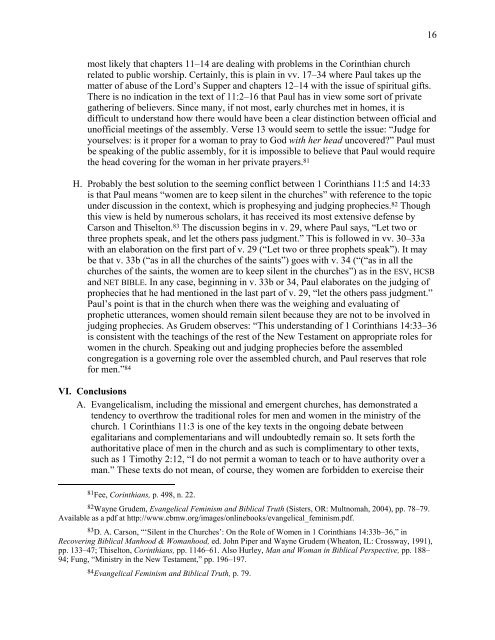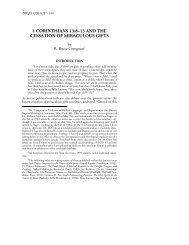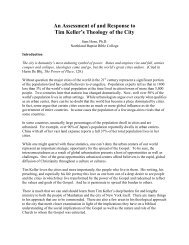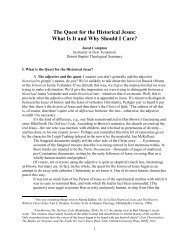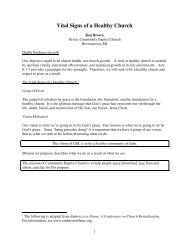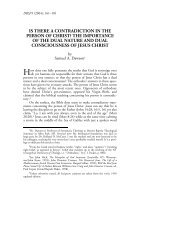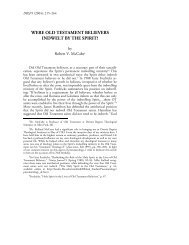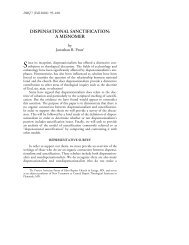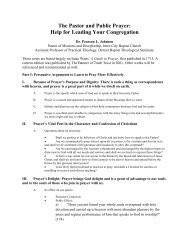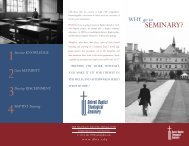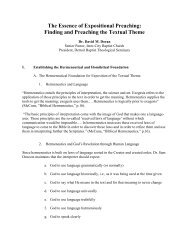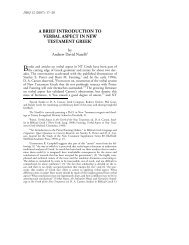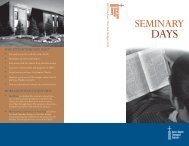Combs, Role of Women in the Church - Detroit Baptist Theological ...
Combs, Role of Women in the Church - Detroit Baptist Theological ...
Combs, Role of Women in the Church - Detroit Baptist Theological ...
Create successful ePaper yourself
Turn your PDF publications into a flip-book with our unique Google optimized e-Paper software.
16most likely that chapters 11–14 are deal<strong>in</strong>g with problems <strong>in</strong> <strong>the</strong> Cor<strong>in</strong>thian churchrelated to public worship. Certa<strong>in</strong>ly, this is pla<strong>in</strong> <strong>in</strong> vv. 17–34 where Paul takes up <strong>the</strong>matter <strong>of</strong> abuse <strong>of</strong> <strong>the</strong> Lord’s Supper and chapters 12–14 with <strong>the</strong> issue <strong>of</strong> spiritual gifts.There is no <strong>in</strong>dication <strong>in</strong> <strong>the</strong> text <strong>of</strong> 11:2–16 that Paul has <strong>in</strong> view some sort <strong>of</strong> privatega<strong>the</strong>r<strong>in</strong>g <strong>of</strong> believers. S<strong>in</strong>ce many, if not most, early churches met <strong>in</strong> homes, it isdifficult to understand how <strong>the</strong>re would have been a clear dist<strong>in</strong>ction between <strong>of</strong>ficial andun<strong>of</strong>ficial meet<strong>in</strong>gs <strong>of</strong> <strong>the</strong> assembly. Verse 13 would seem to settle <strong>the</strong> issue: “Judge foryourselves: is it proper for a woman to pray to God with her head uncovered?” Paul mustbe speak<strong>in</strong>g <strong>of</strong> <strong>the</strong> public assembly, for it is impossible to believe that Paul would require<strong>the</strong> head cover<strong>in</strong>g for <strong>the</strong> woman <strong>in</strong> her private prayers. 81H. Probably <strong>the</strong> best solution to <strong>the</strong> seem<strong>in</strong>g conflict between 1 Cor<strong>in</strong>thians 11:5 and 14:33is that Paul means “women are to keep silent <strong>in</strong> <strong>the</strong> churches” with reference to <strong>the</strong> topicunder discussion <strong>in</strong> <strong>the</strong> context, which is prophesy<strong>in</strong>g and judg<strong>in</strong>g prophecies. 82 Thoughthis view is held by numerous scholars, it has received its most extensive defense byCarson and Thiselton. 83 The discussion beg<strong>in</strong>s <strong>in</strong> v. 29, where Paul says, “Let two orthree prophets speak, and let <strong>the</strong> o<strong>the</strong>rs pass judgment.” This is followed <strong>in</strong> vv. 30–33awith an elaboration on <strong>the</strong> first part <strong>of</strong> v. 29 (“Let two or three prophets speak”). It maybe that v. 33b (“as <strong>in</strong> all <strong>the</strong> churches <strong>of</strong> <strong>the</strong> sa<strong>in</strong>ts”) goes with v. 34 (“(“as <strong>in</strong> all <strong>the</strong>churches <strong>of</strong> <strong>the</strong> sa<strong>in</strong>ts, <strong>the</strong> women are to keep silent <strong>in</strong> <strong>the</strong> churches”) as <strong>in</strong> <strong>the</strong> ESV, HCSBand NET BIBLE. In any case, beg<strong>in</strong>n<strong>in</strong>g <strong>in</strong> v. 33b or 34, Paul elaborates on <strong>the</strong> judg<strong>in</strong>g <strong>of</strong>prophecies that he had mentioned <strong>in</strong> <strong>the</strong> last part <strong>of</strong> v. 29, “let <strong>the</strong> o<strong>the</strong>rs pass judgment.”Paul’s po<strong>in</strong>t is that <strong>in</strong> <strong>the</strong> church when <strong>the</strong>re was <strong>the</strong> weigh<strong>in</strong>g and evaluat<strong>in</strong>g <strong>of</strong>prophetic utterances, women should rema<strong>in</strong> silent because <strong>the</strong>y are not to be <strong>in</strong>volved <strong>in</strong>judg<strong>in</strong>g prophecies. As Grudem observes: “This understand<strong>in</strong>g <strong>of</strong> 1 Cor<strong>in</strong>thians 14:33–36is consistent with <strong>the</strong> teach<strong>in</strong>gs <strong>of</strong> <strong>the</strong> rest <strong>of</strong> <strong>the</strong> New Testament on appropriate roles forwomen <strong>in</strong> <strong>the</strong> church. Speak<strong>in</strong>g out and judg<strong>in</strong>g prophecies before <strong>the</strong> assembledcongregation is a govern<strong>in</strong>g role over <strong>the</strong> assembled church, and Paul reserves that rolefor men.” 84VI. ConclusionsA. Evangelicalism, <strong>in</strong>clud<strong>in</strong>g <strong>the</strong> missional and emergent churches, has demonstrated atendency to overthrow <strong>the</strong> traditional roles for men and women <strong>in</strong> <strong>the</strong> m<strong>in</strong>istry <strong>of</strong> <strong>the</strong>church. 1 Cor<strong>in</strong>thians 11:3 is one <strong>of</strong> <strong>the</strong> key texts <strong>in</strong> <strong>the</strong> ongo<strong>in</strong>g debate betweenegalitarians and complementarians and will undoubtedly rema<strong>in</strong> so. It sets forth <strong>the</strong>authoritative place <strong>of</strong> men <strong>in</strong> <strong>the</strong> church and as such is complimentary to o<strong>the</strong>r texts,such as 1 Timothy 2:12, “I do not permit a woman to teach or to have authority over aman.” These texts do not mean, <strong>of</strong> course, <strong>the</strong>y women are forbidden to exercise <strong>the</strong>ir81 Fee, Cor<strong>in</strong>thians, p. 498, n. 22.82 Wayne Grudem, Evangelical Fem<strong>in</strong>ism and Biblical Truth (Sisters, OR: Multnomah, 2004), pp. 78–79.Available as a pdf at http://www.cbmw.org/images/onl<strong>in</strong>ebooks/evangelical_fem<strong>in</strong>ism.pdf.83 D. A. Carson, “‘Silent <strong>in</strong> <strong>the</strong> <strong>Church</strong>es’: On <strong>the</strong> <strong>Role</strong> <strong>of</strong> <strong>Women</strong> <strong>in</strong> 1 Cor<strong>in</strong>thians 14:33b–36,” <strong>in</strong>Recover<strong>in</strong>g Biblical Manhood & Womanhood, ed. John Piper and Wayne Grudem (Wheaton, IL: Crossway, 1991),pp. 133–47; Thiselton, Cor<strong>in</strong>thians, pp. 1146–61. Also Hurley, Man and Woman <strong>in</strong> Biblical Perspective, pp. 188–94; Fung, “M<strong>in</strong>istry <strong>in</strong> <strong>the</strong> New Testament,” pp. 196–197.84 Evangelical Fem<strong>in</strong>ism and Biblical Truth, p. 79.


